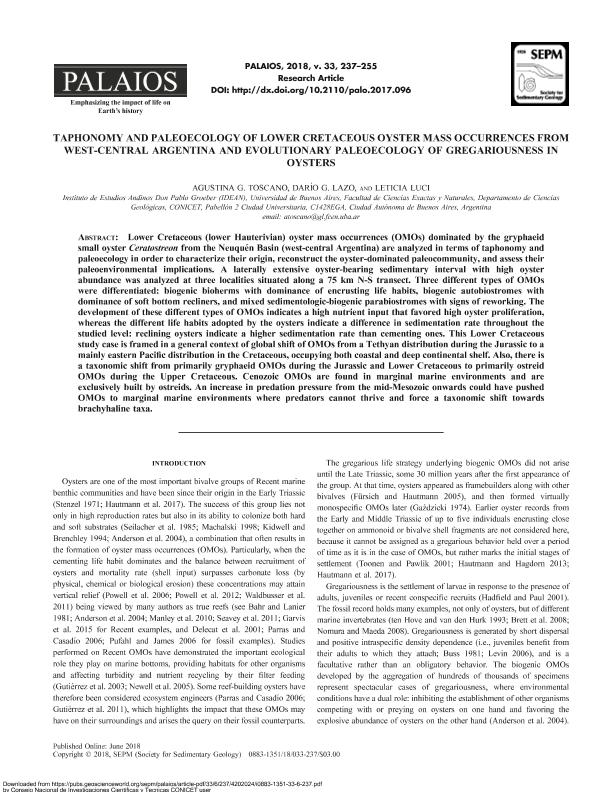Artículo
Taphonomy and paleoecology of lower cretaceous oyster mass occurrences from west-central Argentina and evolutionary paleoecology of gregariousness in oysters
Fecha de publicación:
06/2018
Editorial:
Society for Sedimentary Geology
Revista:
Palaios
ISSN:
0883-1351
Idioma:
Inglés
Tipo de recurso:
Artículo publicado
Clasificación temática:
Resumen
Lower Cretaceous (lower Hauterivian) oyster mass occurrences (OMOs) dominated by the gryphaeid small oyster Ceratostreon from the Neuquen Basin (west-central Argentina) are analyzed in terms of taphonomy and paleoecology in order to characterize their origin, reconstruct the oyster-dominated paleocommunity, and assess their paleoenvironmental implications. A laterally extensive oyster-bearing sedimentary interval with high oyster abundance was analyzed at three localities situated along a 75 km N-S transect. Three different types of OMOs were differentiated: biogenic bioherms with dominance of encrusting life habits, biogenic autobiostromes with dominance of soft bottom recliners, and mixed sedimentologic-biogenic parabiostromes with signs of reworking. The development of these different types of OMOs indicates a high nutrient input that favored high oyster proliferation, whereas the different life habits adopted by the oysters indicate a difference in sedimentation rate throughout the studied level: reclining oysters indicate a higher sedimentation rate than cementing ones. This Lower Cretaceous study case is framed in a general context of global shift of OMOs from a Tethyan distribution during the Jurassic to a mainly eastern Pacific distribution in the Cretaceous, occupying both coastal and deep continental shelf. Also, there is a taxonomic shift from primarily gryphaeid OMOs during the Jurassic and Lower Cretaceous to primarily ostreid OMOs during the Upper Cretaceous. Cenozoic OMOs are found in marginal marine environments and are exclusively built by ostreids. An increase in predation pressure from the mid-Mesozoic onwards could have pushed OMOs to marginal marine environments where predators cannot thrive and force a taxonomic shift towards brachyhaline taxa.
Palabras clave:
Oyster
,
Cretaceous
,
Bioherm
,
Biostrome
Archivos asociados
Licencia
Identificadores
Colecciones
Articulos(IDEAN)
Articulos de INSTITUTO DE ESTUDIOS ANDINOS "DON PABLO GROEBER"
Articulos de INSTITUTO DE ESTUDIOS ANDINOS "DON PABLO GROEBER"
Citación
Toscano, Agustina Gabriela; Lazo, Dario Gustavo; Luci, Leticia; Taphonomy and paleoecology of lower cretaceous oyster mass occurrences from west-central Argentina and evolutionary paleoecology of gregariousness in oysters; Society for Sedimentary Geology; Palaios; 33; 6; 6-2018; 237-255
Compartir
Altmétricas




